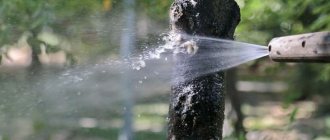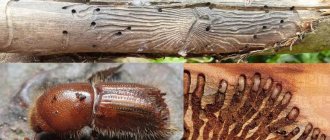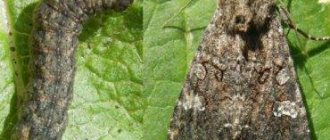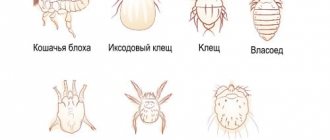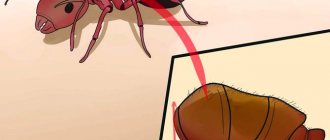A little theory
Voles are small rodents that are also called field or meadow mice due to their similar appearance.
There are two widespread species of voles in North America: prairie and meadow voles. The habitat of the former is prairies, while the latter live absolutely everywhere, and therefore are more numerous. They are very similar to each other, and the methods of fighting and control are practically the same. These seemingly cute rodents can cause significant damage to your garden. Don't confuse them with mice, which don't cause as much damage. Voles happily eat a wide variety of plants, as well as the bark of some trees. If you find that your plantings have been attacked, be sure to conduct an inspection to identify unwanted guests. Read how to deal with moles?
How to identify a vole
You can distinguish a vole by its rounded ears, which are often hidden by fur, small eyes and a short tail. These are small, squat rodents that look like field mice. The thick fur is usually light brown or gray. Animals love fields rich in weeds and ground cover plants. They are active both day and night, especially in the early hours and dusk.
Distinctive features of voles:
- Voles have a short tail and a blunt muzzle, while the house mouse has a long tail and a pointed muzzle;
- The color of the skin is dark brown or gray;
- The size of the rodent reaches 7-15 cm from nose to tail;
- Small ears and small eyes compared to house mice.
Do not be fooled by the cute appearance and miniature size of voles - they can cause incredible damage not only to the future harvest, but also to the house, garden, and outbuildings.
How to get rid of a vole
The following are several effective ways to combat small rodents. Some of them will definitely work in your case.
Try setting humane traps near burrows and nesting sites in bush areas. Place peanut butter baits in the early evening when voles are most active and move the traps as often as necessary to get rid of them. Take the prisoners away from the site and release them into the field.
In this case, the key to success will be patience and perseverance.
If the problem has reached its peak, you can kill the rodents with a rodenticide. Consult the horticulture department to find an effective and approved product.
To discourage voles from chewing on the bulbs, add gravel to the hole at the time of planting. You can also spray the root vegetables with a fungicide to repel pests. In addition, there are varieties of onions that are resistant to rodents.
A good way would be to plant onions in the fall.
Poisons and mousetraps
Complete eradication of rodents requires persistence and takes a lot of effort and time. You can simplify your task with the help of a special device that is placed on the site and repels field mice at a distance of up to 185 square meters. m..
The device runs on batteries, so protection from rain is required to prevent the contacts from oxidizing.
Mousetraps
If you don’t have an ultrasonic repeller at hand, you can get by with a proven remedy - ordinary mousetraps. It is most effective to install them in early spring or late autumn. At this time, voles reproduce especially actively. Rodent control during these seasons is the best way to control the rodent population and prevent the proliferation of rodent colonies.
The choice of mousetraps is huge. For those who are disdainful of messing with dead mice, they have come up with disposable traps. To solve the problem, both the simplest and the most complex are equally suitable.
Place mousetraps perpendicular to the runways, inside and on the approach to tunnels. Apples, oatmeal or peanut butter are suitable baits. For maximum effect, cover the mousetrap with an upside down box. This will protect children and pets from traps.
Check mousetraps daily and discard dead animals immediately. Under no circumstances leave this for later, as mice do not disdain eating their relatives. In addition, dead animals attract more dangerous pests. If the mousetrap remains empty for several days, move it to another location.
Poison is one of the most effective means of self-control against rodents. But you need to use poisoned bait very carefully: the poison is fatal to both humans and domestic and wild animals. Poison left outside can easily get into the water supply.
The best season for using poisons is considered to be the end of winter - the beginning of spring. Reducing the amount of food available makes voles less picky about their food choices.
Always read the instructions for use carefully. To minimize the availability of poisonous bait to children and pets, place the poison directly into the burrows and use special bait containers.
Preventive measures
To discourage voles from invading your garden at an early stage, there are several simple ways. Preferring a dense protective vegetation cover of weeds and mulch that provides food and protection from predators, rodents react negatively to active weeding and pruning of bushes. Make your yard inhospitable to voles by creating as much clear space as possible.
Fortunately, these pesky animals are not the best climbers. Therefore, to protect vegetable plantings from rodents, surround them with a metal mesh at least 30 cm high and dig it into the ground to the same depth.
Of course, the best watchman will be a street cat, which effectively fights all types of mouse-like pests.
Most of the methods you can use to get rid of mice can be applied to voles. Always remember to use humane methods of control, leaving the animals unharmed unless it is absolutely necessary to use chemicals.
Video about fighting voles
What do we know about voles?
Among rodents and garden pests there are many very original specimens - such as the shrew, water rat, and mole. But the vole can easily claim the title of the most common species of garden inhabitants. What do we know about her? This rodent is characterized by:
- small size - the mouse usually weighs no more than 30 grams, grows up to 12 cm in length;
- nocturnal - during the day they prefer to hole up in houses built of grass or burrows;
- year-round activity - the pest does not hibernate and is very inventive in searching for food in winter;
- gluttony - during the day one rodent eats a volume of food equal to its own weight;
- fertility - in a year one female can give birth to 3-4 litters of mice, each of which will contain up to 8 individuals.
What indicates the appearance of mice
At first glance, it is difficult to determine that you have a vole in charge. But there are several sure signs that are characteristic only of these rodents.
The most eloquent evidence is small tunnels on the surface of the earth. They are also called "runways". If there are such on your site, you can rest assured: voles have settled here.
"Runways" look different: like tunnels of grass or grooves in the ground. Dimensions range from 3 to 5 cm in width and up to 1.5 cm in depth. This is the result of the vital activity of voles, which feed mainly on the roots and stems of grass. They, just like mice, walk the same paths.
Vole burrows are also easy to spot. These are small holes in the ground, up to 2 cm in diameter. Near the entrance there is a small volcano-shaped mound of earth. The burrows of these rodents can be identified by their greenish droppings, which turn gray or brown over time.
Small rodents make tunnels not only in grass and soil. Tubers of vegetables, roots of trees and flowers are not a hindrance for them, so green spaces and crops are at risk.
Trees and shrubs suffer not only from roots damaged by voles. Voles gnaw off the root bark, making the bush or tree especially vulnerable to diseases and pests. Violated natural protection leads to the death of the plant.
Mice infestations are often observed in the spring. This is explained by the fact that in winter they quickly master and adapt to life in the home and behave like a boss.
Symptoms that mice have settled in your dacha:
- mouse droppings along baseboards and in corners,
- cardboard boxes and bags with bulk products that have been chewed by animals,
- eaten clothes, textiles, blankets, etc.,
- paths trampled in dust along the walls,
- perforated lining,
- characteristic squeaking, rustling sounds from the movement of rodents.
If you detect at least a couple of such symptoms, you should act urgently, since mice, like other rodents, reproduce very quickly.
How to get rid of field mice and voles in the country?
The search for methods of catching or ridding an area of garden pests is a more than relevant topic. It is very difficult to choose one method or specific means due to the extreme caution and ingenuity of rodents. You can use one of two tactics: offensive or preventive.
Read also: Yellowing of anthurium leaves: possible diseases and how to treat the flower
Experts advise:
Poisoned baits, pesticides and traps in the case of field mice may not give the desired result. The fact is that it is better to place such means of control away from the free access of children and pets. If you cannot limit accessibility, there is a high risk that instead of a mouse, someone for whom it was not intended at all will stumble upon a dangerous “surprise.” The use of radical methods is best left to professionals.
Preventive methods
To carry out treatment against field mice without endangering the life and health of others, you can pay attention to folk remedies and methods. For example, plants that have a strong unpleasant odor can be used as a means of control. These include elderberry and garlic. You can also place them soaked in strong-smelling substances of chemical origin - kerosene, ammonia, in burrows found on the territory of your land plot.
Another effective solution is to fight with sound or vibration. Cans and plastic bottles tied to a pole can be used as a source of noise.
Contacting specialists
Feedback from our client: We ordered treatment for country voles - the mice became insolent, they dug up the entire area in the spring, and in the winter they gnawed at the base of the trunk of young trees. The specialists arrived quickly, the price was adequate for the volume of work, they offered premium, odorless preparations, and explained everything in detail. Two months have passed - not a single new hole or traces of mice remain.
What harm do field mice cause in the country?
Many different problems are associated with the appearance of field mice in the country:
- damage to fruit plants and their root system;
- violation of the integrity of brick, wood and concrete walls;
- damage to garden and home furniture;
Vole mouse.
- damage to fruits, buds and inflorescences of plants;
- violation of soil fertility due to many underground passages and tunnels;
- destruction or damage to food supplies in storage facilities;
- spread of pathogens of dangerous diseases.
Description and photo of the pest
The water rat is the largest representative of voles; we suggest that you familiarize yourself with its photo and consider its description. Belongs to the hamster family.
The rodent has a small muzzle and a massive body, its length reaches 25 cm, and its tail - 15 cm. The body is covered with thick hair, and the tail is bristly. Color – gray, red or almost black.
Who are field mice?
What’s most interesting is that voles are quite distant relatives of rats, since they belong to the hamster family. But no one gave the hamsters a personal year, and they decided to join the rats. For most people who like to celebrate, this is generally typical.
Lemmings, water rats, muskrats, mole voles, and pieds are also classified as voles. There are almost one and a half hundred different types of them there. But this is a vast topic, so we will talk about the most common common voles (Microtus arvalis), as well as about the Eastern European voles (Microtus levis), distinguishable from them only by the number of chromosomes - you have to camouflage yourself like that!
That is, it is already clear that they are as close to rats and mice as wolves are to tigers, although they are very similar to mice. Voles are distinguished by a shorter tail (in mice it is longer than the body, and in voles it is shorter). And also smaller ears and wider muzzles. This is if you compare two animals sitting next to each other, which are not always at hand. This means that the tail is the defining element. You can also distinguish by the teeth and the quality of the undercoat, but it is better for specialists to look into the mouth and pull the fur; they are not the first to conduct all sorts of experiments on animals.
Voles are usually small, the body is 5-10 cm and the tail is 4 centimeters, maximum. The largest animals weigh no more than 45 grams, more often around 20-25. The color consists of a combination of gray and brown of various shades, with the belly being lighter than the back. Looks like a small soft toy. Very vulnerable: there is a known case when a vole fainted and died from the heart-rending cry of a woman who was frightened by this tiny creature.
Everyone tries to offend a vole: snakes and large lizards eat them with pleasure; for weasels, ferrets, martens, foxes - they are, in general, the main food. In times of hunger, wild boars, wolves, and badgers snack on voles. As soon as voles appear in an open place, a kite or a hawk, or even an eagle, falls from the sky. Even jays, not the most predatory birds, even snack on voles. At night, too, there is no peace: every minute an owl or an owl will swoop down from above, and a hungry hedgehog is prowling around below. Therefore, in natural conditions, an animal older than two years is considered an old-timer and an aksakal.
In such conditions, they have to reproduce with incredible speed, which they do, leaving even rabbits behind. They begin as soon as conditions allow, from March-April and end in October-November. In winter, they can also reproduce if they find an insulated place: a haystack, for example, or they climb into a house. It’s especially good in a haystack - warmth and food all around.
Pregnancy in females lasts 20 days, and the next one can occur almost immediately; feeding is not a hindrance. Most often 4-7 babies are born, but there can be 2-15. After 20-40 days (depending on the season), the babies become sexually mature and are actively involved in the reproduction process. Further on increasing.
Common vole (Microtus arvalis)
Features of the life cycle and habitat
It lives on the banks of rivers, ponds and lakes, and during high water it comes out to fields, meadows and vegetable gardens. When the water level drops to normal, it returns home.
The water rat makes its home in reeds, old stumps and on coastal hummocks. This pest can cause significant damage to your garden.
The rat destroys the bark of trees, feeds on vegetable crops, and destroys the fertile layer of soil with its underground passages. The rodent comes to the surface only in secluded, cluttered places.
Important! Water rats reproduce very quickly; over the summer they can give birth (4-7 pieces) several times.
What's the harm?
The scary thing about these rodents is that they are incredibly omnivorous. They destroy both the harvested crop and the rhizomes and tubers that grow on the site.
In the autumn, they get closer to people and gardens in order to easily obtain food. The rodent digs through shallow underground passages, damaging the soil and plants that it encounters along its path.
Find out how to get rid of mice, vipers and mole rats from your site.
Voles are often confused with moles, but moles do not eat vegetables such as carrots, beets and potatoes, and the voracious water rat can destroy an entire crop.
At the same time, thoughtful animals do not eat everything at once, but make preparations from small vegetables for the winter, but those that cannot be dragged through their underground passages are destroyed on the spot.
They can harm plants not only by eating them, but also by plowing the soil and disrupting the growth of the root system of flowers, shrubs and trees.
It is not so easy to find a place from which a water rat comes out to hunt for crops, since most often the animal makes exits in secluded places, these can be heaps of garbage, compost pits, areas of the garden where heaps of branches or stones are located.
How to fight?
A rat that has settled on your property can cause enormous harm, and we will try to figure out how to deal with it. The main thing is not to delay, otherwise you may lose the harvest.
Did you know? The water rat has many enemies, such as stoats, large birds of prey and even pikes.
Humane methods
One of these methods is repelling rats with special devices emitting ultrasound. The unpleasant sound irritates the pest’s hearing organs, and it leaves its home.
It is believed that rats are able to get used to this sound and return to their homes, so when choosing such a device, you should pay attention to repellers that automatically change the range and frequency of the sound.
Read also: Planting indoor flowers in a pot
There are also traditional methods of combating these dangerous rodents. Due to the fact that the animal has a very well developed sense of smell, influencing rats using odors is considered quite effective.
In order to use this option, you will need a rabbit (or other) skin, it must be rolled up, placed in a hole and set on fire. Due to the strong stench, rats will either suffocate or leave their homes forever.
You can prepare a mixture of water and ash and pour it into underground passages. On the one hand, this will block the movement of the pest, and on the other, the unpleasant smell will also play a role.
Radical ways
The water vole is a rather cunning animal, so methods of dealing with it must be carefully thought out. Radical methods include all kinds of poisons.
Chemicals are best used in the fall or spring, during the breeding season of rodents. It is not enough to simply spread the poisonous substance around the garden plot, but it is necessary to carefully disguise it.
In the fall, it is best to add poison to the grain and spread it in front of the entrances to the burrows. In spring, bait is best made from grated potatoes, carrots and pumpkin. Oatmeal and peas are also suitable for masking.
Important! Poison baits are very toxic; do not use this method if you have pets that roam freely around the area.
You can make bait with your own hands; to do this, you need to take alibaster or gypsum, sunflower oil and flour, mix with a wooden stick until a thick mass is formed and place the container with it at the exit of the hole.
Then the integrity of the poison is observed; if traces of a rodent are noticeable, you can fill the passages with soil, and the bait should be left for some time to make sure that all rodents are exterminated.
When using radical methods, it is necessary to take into account the fact that the corpses of poisoned animals can be scattered throughout the garden. They must be identified and burned as early as possible to prevent toxic substances from penetrating the soil.
How to deal with mice and voles
To get a significant positive result in the fight against voles, you should be guided by a number of factors. For example:
- It is imperative to take preventive measures that prevent the appearance of rodents on a dacha or household plot.
- It would be a good idea to use physical control methods if there are too many pests on the site.
Over the centuries, people have come up with a lot of ways to control pests. At the same time, it should be noted that there are 3 main ways to get rid of rodents:
- Using folk remedies that are environmentally friendly and absolutely harmless to humans.
- Physical methods of control, using all kinds of traps, mousetraps, snares, etc. The cat, which is a natural enemy of mice, is also included in this category, although modern cats are not very predisposed to fighting mice.
- Based on chemical components, in the form of poisons, aerosols, baits, etc. Chemical control agents do an excellent job, especially if the pest population is large enough, but they are not safe for humans and domestic animals.
When choosing one or another method of getting rid of these voracious animals, you should pay attention to the conditions for using control agents. This is the only way to get rid of rodents and not harm your health, as well as the future harvest.
Folk remedies
Oddly enough, but where there is a man, there are mice. Therefore, a person always had to look for means that could help get rid of such a neighborhood. Man, through trial and error, managed to find out which plants pests avoided and began to prepare infusions and decoctions based on them, and used some of them fresh or dried. Therefore, when starting the fight against mice, it is better to use chemical means of control as a last resort, having actually tested drugs based on natural ingredients.
Recipes from the people against field mice:
- Take wheat flour and lime in equal quantities, as well as a pinch of salt . All ingredients are combined together and mixed thoroughly. The bait is laid out in small containers and placed where rodents prefer to appear. You need to place water next to the bait, since without it the active action of the product will not work. When the mouse eats, it will immediately drink water, which will activate the lime. As a result, a blood clot forms in the animal’s stomach, which leads to death.
- During the summer, you should consider stocking up on some herbs such as wormwood, mint, wild rosemary, tansy, etc. Herbs are laid out in boxes in the kitchen, in cellars, pantries and other rooms where these animals can manage. Bouquets of such herbs are laid out around the entire perimeter of the house, and they are also tied around fruit trees.
- If there are no herbs, then you can use essential oils of these plants . If you moisten small pieces of fabric with oils and place them in places where rodents are most concentrated, then they will not appear in these places. Essential oils of coniferous trees, citrus fruits, and tansy oils are used.
Physical methods of struggle
Most owners prefer to use various traps to combat voles. At the same time, you have to constantly remove dead rodents every morning. There are more humane mechanisms that keep these animals alive, but here you need to be prepared for the fact that mice released into the wild will again come to spoil the harvest. In any case, the neighbors will definitely have them.
Self-made traps are quite effective, despite the ease of manufacture. Homemade traps:
- Glue mousetrap. Regular glue will also work, but it is better to use a special glue that is designed for this purpose. It contains components that attract rodents with their aroma. In addition, the composition includes a toxic substance. To make a trap, you need to take a piece of cardboard or other material and apply adhesive in strips up to 5 cm wide. It is better to put bait (optional) in the center of the trap, which will make the trap more effective.
- Mousetrap from a jar . Take a half-liter jar and place bait on its bottom. The walls inside the jar are covered with a thin layer of butter. The jar should be installed so that the rodent can easily get inside the jar. If this happens, the pest is unlikely to be able to get out.
Can vs Mouse
Chemicals
The advantage of chemicals is their instant action, which guarantees getting rid of pests in a short period of time.
Effective drugs include:
- "Storm" wax tablets . The tablets have a more deterrent effect, but if a rodent wants to taste them, it will die within 2 weeks.
- Universal "Granules" . The product is made on the basis of natural wheat grains. It does not act immediately, so individuals have time to infect the rest of their relatives. Using this remedy, it is possible to get rid of an entire colony.
- Glue "Musquidan" . Intended for the manufacture of special traps. The glue is applied to the cardboard, and the bait is placed in the center. When the mouse wants to try the bait, it will stick and then die.
The vole mouse has many natural enemies: owls, martens, foxes, and weasels. It is worth noting that an owl can eat up to 2 thousand mice in 1 year. The weasel is small in size and penetrates mouse holes, destroying entire offspring. The fox also feasts on mice, especially in winter.
How to keep rats out of your property?
The water rat is a cunning and intelligent animal, there are effective methods to get rid of it, but it is always much better to prevent the problem than to look for ways to solve it.
It is always necessary to maintain order in your area, since thickets and littered places are excellent for masking the passages of these pests; this is where they develop exits to the surface that can go unnoticed for a long time.
Surround your area with a hedge of thorny plants; roses and rose hips are suitable for this purpose.
Did you know? The water rat can carry the disease tularemia
.
The water vole, although not scary if you look at the photo, is a very harmful animal, as evidenced by its lifestyle and description. If you are lucky enough to own a plot of land near a pond, always keep your finger on the pulse so as not to give the pest a single chance to ruin your garden, flower bed and vegetable garden.
Water voles: appearance and distribution
Water voles are sometimes called water rats or mice, but, strictly speaking, they have a very indirect relationship with these rodents, despite their external resemblance to them. These animals actually belong to the hamster family, although they bear little resemblance to the familiar domestic hamsters. Water voles look about the same as common voles, but they are noticeably larger. An adult can reach 15–25 cm, with the tail making up most of its length.
Water voles prefer to live in wetlands
This animal has thick, fluffy dark gray fur from the beginning of its short muzzle to the base of its tail, which is covered with hair and has a small tassel at the end.
You can meet the vole almost throughout the entire territory of Eurasia - right up to Siberia and the North Caucasus. Most of all, she likes marshy areas and the banks of reservoirs, but fields, meadows and even vegetable gardens are also excellent for their life. These animals are very tenacious and prolific, so nothing threatens their spread.
Read also: Growing white spirea in the garden, planting and caring for the plant
Damage caused by voles
If your summer cottage is located in a rural area, especially near rivers, lakes and swamps, prepare for the appearance of uninvited guests. Water voles, despite their name, live well in drier areas, including farms, vegetable warehouses, granaries, home gardens and vegetable gardens.
Small depressions (burrows) will appear in your area if water voles appear there
Video: rodent nutritional features
Types of mice
There are a great variety of mice, but most of them are adapted to the wild and do not try to get into people's homes. At the moment, there are three large species of mice that cannot live separately from humans or are in some way dependent on anthropogenic factors.
House mouse
The most common species, which can be found anywhere, with the exception of the Far North, highlands and Antarctica. These mice do not tolerate cold well , so in winter they run towards people. With the onset of warmth, many may leave people's homes.
House mouse
House mice reproduce very actively. In a year, one female can easily give birth to from 15 to 30 mice, and under good conditions even more. It follows from this that it will be extremely difficult to fight them, since mice reach maturity a few weeks after birth.
In the wild, the house mouse loves plants, especially grass, flowers and their seeds. Sometimes it can eat small insects. Having moved closer to humans for the winter, it becomes omnivorous . Mice often overeat, so they may leave behind food that has been gnawed on all sides and is no longer edible.
Vole
Oddly enough, voles belong not to the mouse family, but to the hamster family, being distant relatives of lemmings and muskrats. But, despite their somewhat noble origin, they still bother with their presence in a country house. These parasites are widespread over a vast territory - from Mongolia and Kazakhstan to Finland.
Vole
Voles do not reproduce as quickly as house mice, and they usually do this in the summer. They also don’t live long, only four and a half months. In the wild, they also feed on plants and roots; in people’s homes they become omnivores. In summer they can destroy flower bulbs in flower beds, and in winter they can gnaw off the bark of fruit trees.
Shrew
In appearance, the shrew is similar to an ordinary mouse, but is distinguished by its elongated muzzle with a proboscis.
It is difficult to call the shrew a pest, since its diet includes insects that feed on cultivated crops. However, along with its useful work, this rodent can easily plow up the entire garden, including the cultivated crops it protects. Therefore, the shrew does much more harm than good.
This animal does not reproduce so actively, and it eats plant foods only in extreme cases.
In addition to the rodents described above, moles can visit your garden, but these cute creatures are not as dangerous as mice.
Shrew
Ways to control water voles
Few villagers or summer residents are willing to share their harvest with rodents. Therefore, people try to get rid of them as soon as possible. It’s good if a trained mouse-cat or ferret lives in your house. These predators are able to catch those pests that managed to run into the area, and also force others to avoid your garden.
But what if your pet is not interested in hunting or you don’t have one at all?
Chemicals against voles
There is another option for using chemicals. In the spring, you can place cotton wool or dry grass treated with poison near the holes. The voles drag it into their homes to furnish the “interior,” while the poisoned dust falls on the fur of the pests, after which it is licked off by them.
Photo gallery: popular rodenticides
Folk ways to get rid of the problem
The second group of folk remedies is aimed at scaring away animals. Here you can use the following options:
- Smell of chemicals. Many people advise soaking pieces of rags or cotton wool with strong-smelling household liquids and plugging voles’ passages with them. Typically, gasoline, kerosene, turpentine and Vishnevsky ointment are used for impregnation. The strong smell repels rodents.
Burnt wool. It is believed that garden pests, including voles, cannot tolerate this smell. Some gardeners burn the corpses of captured rodents and place the charred remains in the burrows of those who are still alive. But it’s enough to just singe pieces of some unnecessary, old fur and put them on it - the effect will be the same.
Fresh manure. Another option to add to the collection of unpleasant odors. It is recommended to put the product in rodent burrows, blocking all the exits that can be found on the site.
Unpleasant sounds. In the area of vole burrows, 1.5–2-meter hollow reed stalks or ordinary glass bottles are dug deep into the ground. In windy weather, these improvised “pipes” begin to vibrate and make sounds that frighten the animals.
The bottles are dug into the ground with the neck up so that the wind can easily penetrate inside.
Vegetation barrier
A great way to scare away water voles and prevent new ones from appearing is to properly plant garden crops and plant special anti-rodent plants. To do this, various types of legumes (beans, beans, peas), sweet peppers, onions and garlic should be planted around the vegetable beds that you want to protect from pests.
Some vegetable crops are real enemies of water voles
It is worth planting fragrant herbs under the trees, around the bushes and in the flower garden. The best options for repelling voles are wormwood, mint, celandine, elderberry and black root (it is even popularly called a ratter). Coriander, chamomile, wild rosemary and lovage are also suitable.
